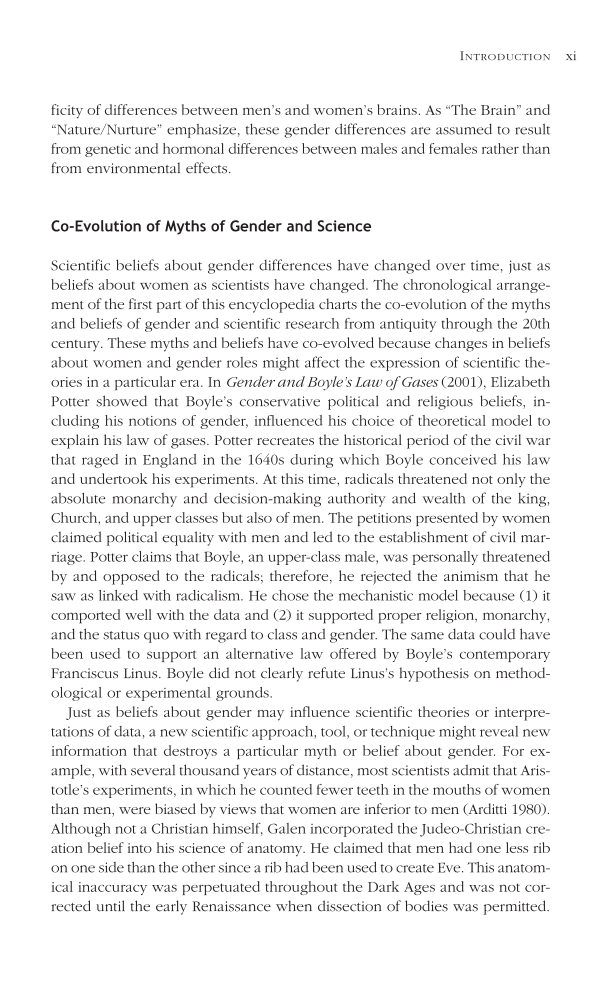ficity of differences between men’s and women’s brains. As “The Brain” and “Nature/Nurture” emphasize, these gender differences are assumed to result from genetic and hormonal differences between males and females rather than from environmental effects. Co-Evolution of Myths of Gender and Science Scientific beliefs about gender differences have changed over time, just as beliefs about women as scientists have changed. The chronological arrange- ment of the first part of this encyclopedia charts the co-evolution of the myths and beliefs of gender and scientific research from antiquity through the 20th century. These myths and beliefs have co-evolved because changes in beliefs about women and gender roles might affect the expression of scientific the- ories in a particular era. In Gender and Boyle’s Law of Gases (2001), Elizabeth Potter showed that Boyle’s conservative political and religious beliefs, in- cluding his notions of gender, influenced his choice of theoretical model to explain his law of gases. Potter recreates the historical period of the civil war that raged in England in the 1640s during which Boyle conceived his law and undertook his experiments. At this time, radicals threatened not only the absolute monarchy and decision-making authority and wealth of the king, Church, and upper classes but also of men. The petitions presented by women claimed political equality with men and led to the establishment of civil mar- riage. Potter claims that Boyle, an upper-class male, was personally threatened by and opposed to the radicals therefore, he rejected the animism that he saw as linked with radicalism. He chose the mechanistic model because (1) it comported well with the data and (2) it supported proper religion, monarchy, and the status quo with regard to class and gender. The same data could have been used to support an alternative law offered by Boyle’s contemporary Franciscus Linus. Boyle did not clearly refute Linus’s hypothesis on method- ological or experimental grounds. Just as beliefs about gender may influence scientific theories or interpre- tations of data, a new scientific approach, tool, or technique might reveal new information that destroys a particular myth or belief about gender. For ex- ample, with several thousand years of distance, most scientists admit that Aris- totle’s experiments, in which he counted fewer teeth in the mouths of women than men, were biased by views that women are inferior to men (Arditti 1980). Although not a Christian himself, Galen incorporated the Judeo-Christian cre- ation belief into his science of anatomy. He claimed that men had one less rib on one side than the other since a rib had been used to create Eve. This anatom- ical inaccuracy was perpetuated throughout the Dark Ages and was not cor- rected until the early Renaissance when dissection of bodies was permitted. INTRODUCTION xi
Document Details My Account Print multiple pages
Print
You have printed 0 times in the last 24 hours.
Your print count will reset on at .
You may print 0 more time(s) before then.
You may print a maximum of 0 pages at a time.









































































































































































































































































































































































































































































































































